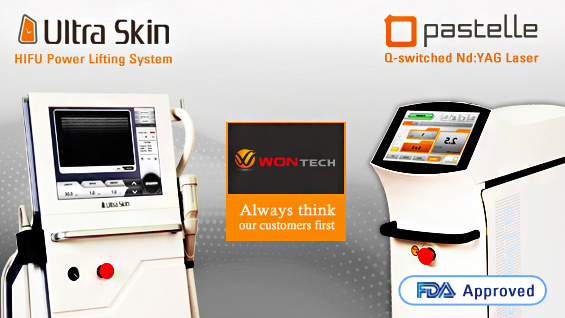▶ Previous Artlcle : #5-1. Understanding IPL
IPL is not laser but its effect can be explained by the concept of selective photothermolysis, an important principle of aesthetic laser. Selective photothermolysis explains the interaction between the chromophore and light. It is one of the most fundamental concepts of therapeutic laser and optical devices. This principle stands on the following three basic rules.
[Advertisement] Ultra Skin/Pastelle – Manufacturer: WONTECH(www.wtlaser.com)
•The light being used must have wavelength that can be first absorbed by the chromophores in the target and reach the depth of the target.
•The light should be irradiated for a short duration before excessive heat is transferred to adjacent tissues.
•Energy delivered per unit area, or the fluence, should be sufficient enough to bring desired effect and at the same time low enough to minimize damage to surrounding tissues.
Applying the principle of selective photothermolysis can help determine the optimal parameters for a specific clinical use. For example, when the hemoglobin is targeted, the most effective wavelength is 585nm. The pigment lasers in this wavelength are used to treat hemangioma. On the other hand, absorption peaks of hemoglobin are 418nm, 542nm, and 580nm and melanin is absorbed in the entire spectrum of visible light in 400~700nm but its absorption decreases toward infrared range. Unlike laser that can select only one wavelength, IPL uses a wider range of wavelengths that can be absorbed into melanin and blood vessels, thereby tackling two targets with one treatment. Moreover, as the light spectrum used in IPL include the absorption peaks of hemoglobin, selective absorption of greater energy is possible.
The size of target structure and pulse duration also affect the selective destruction of target tissue. When heat is gradually transferred to coexisting large and small structures, the small structure delivers heat slowly to surrounding tissues over an interval longer than its thermal relaxation time without incurring damage. Therefore, this phenomenon allows irradiating light of one wavelength on structures with the chromophores to selectively destroy the large structure without damaging the small one.
For example, for small targets such as epidermal melanosomes, pulse duration of 10~20msec, longer than their thermal relaxation time of 1μsec, is not long enough to damage the target tissues. On the other hand, this duration induces continuous heat transfer on relatively larger structures such as black hair which eventually damages the follicles and adjacent tissues. This is the fundamental operation principle of IPL and laser hair removal and is particularly significant in patients with darker skin color.
Another unique feature of IPL is its cooling method. The IPL device uses contact cooling method where the light emitting part of the handpiece cools the skin surface by direct contact. The tip of the handpiece uses liquid cooling system. However, unlike laser procedures, besides the cooling system inherent in the device, the cooling gel is applied on the skin before IPL treatment. Here, if the layer of applied cooling gel is too thin, the risk of burn increases, whereas if it is too thick, energy is not sufficiently delivered to the skin, reducing the therapeutic effect. Therefore, caution is needed in applying the cooling gel in appropriate thickness.
This article covered the history as well as mechanical and optical properties of IPL. We will discuss clinical applications of IPL in the following articles.
-To be continued-
▶ Next Artlcle : #6-1. Considerations for clinical application





















